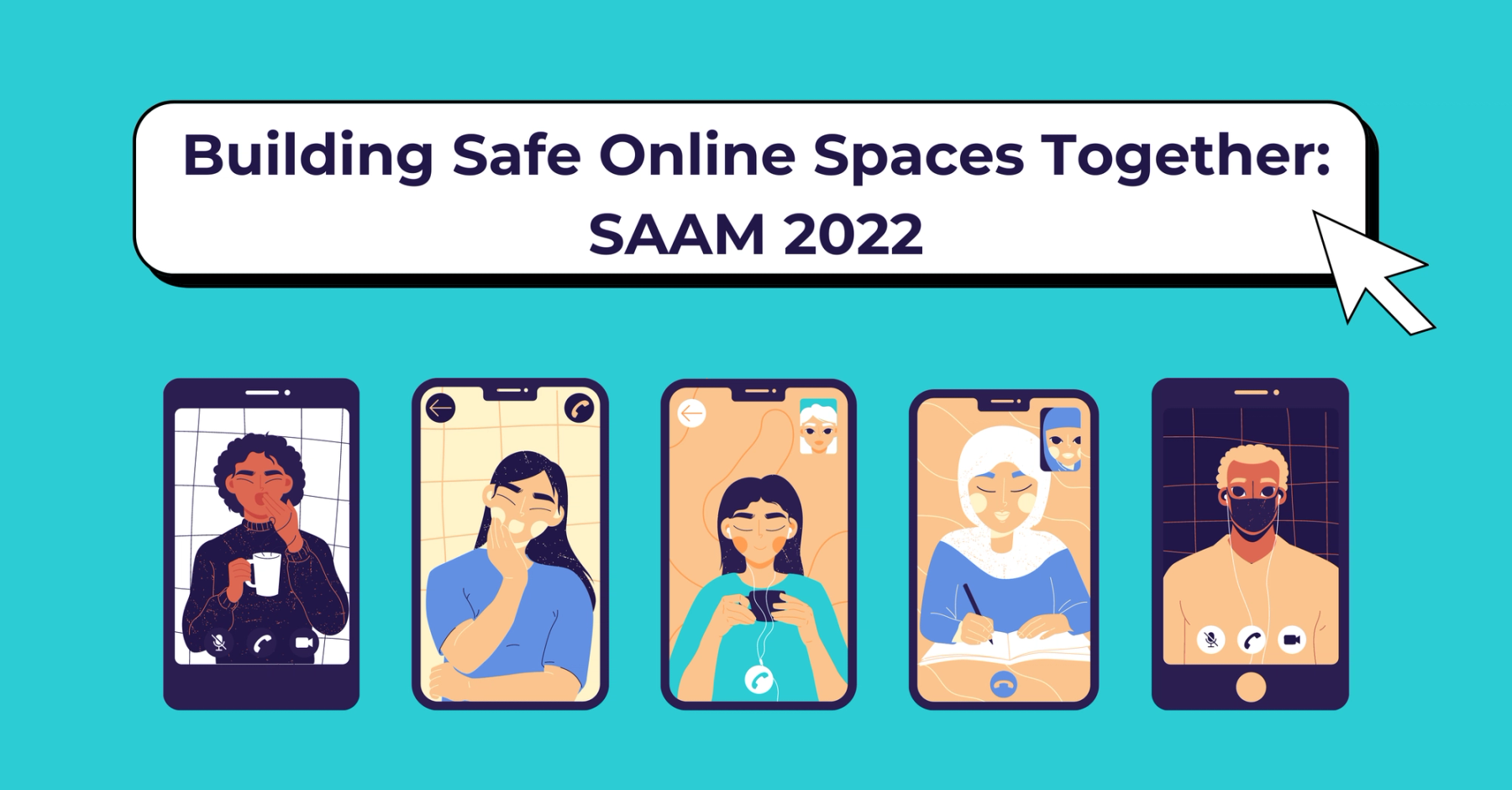April 13th, 2022

This year’s campaign for Sexual Assault Awareness Month (SAAM) is centered around the idea of creating safe, inclusive, and respectful spaces online which will then effectively spill over into our offline interactions as well.
The National Sexual Violence Resource Center (NSVRC) states, “For too long, harassment, cyberbullying, sexual abuse, and exploitation have come to be expected as typical and unavoidable behaviors online.” The phrase, “Building Safe Online Spaces Together,” highlights the idea that we all have a responsibility to become aware of how we are agents of change in the time of modern technology.
This campaign focus suggests that it is imperative- now more than ever- for every one of us to prevent and ultimately put a stop to behaviors that are inappropriate, unhealthy, abusive, and/or exploitative, both in the virtual and ‘real’ worlds. It is important to put a stop to harassment, cyberbullying, abuse, and exploitation by demonstrating respect, safety, and inclusivity in our everyday encounters with others through virtual mediums (i.e. texting, phone calls and voicemails, email, social media, and so on).
This campaign also suggests a vision for us all to strive for a world that exists that does not include harassment, bullying, abuse, and exploitation. Furthermore, it suggests that each year with every campaign, each interaction online that exercises safety and respect for others, every time one of us calls out something that is wrong, every time wecreate spaces that tell survivors, ‘It’s okay to share what happened to you and it’s not your fault’, and so on- we are already building those safer spaces online. We must continue on.
Far too often do we still witness the vitriol that is expressed in virtual spaces where conversations surrounding sexual assault, rape, harassment, and exploitation are being held? There is much work that is yet to be done, but it is possible, one interaction at a time. Necessary for change, we must educate ourselves and others to gain the necessary self-awareness to practice safe behaviors and the courage to fight against unsafe digital interactions.

That said, let us not forget to credit those changemakers in the United States who paved the way for things like sexual violence prevention programs in schools and workplaces, SAAM, NSVRC, rape crisis centers, teal ribbons, and the Violence Against Women Act legislation- to name a few.
The civil rights era is quoted as being the catalyst for the women’s liberation movement which set out to end and prevent sexual violence, among other objectives. The civil rights era gained momentous traction beginning in the 1940’s/-50’s, subsequently serving as a model for the women’s liberation movement in terms of strategies for organization and activist work. These movements were championed by Black women and women of color who were intent on challenging the status quo when it came to race- and gender-based violence. These activists demanded change. These individuals brought attention to the conversations that were just beginning in this period, where experiences of domestic and sexual violence- concepts that were not publicly discussed for centuries- were finally emerging from silenced mouths.
These liberation efforts continued over the decades where, for example, the first rape crisis center was developed in San Fransisco in 1971, and seven years later- also in San Fransisco- the United States’ first ‘Take Back the Night' event was held. These ‘Take Back the Night’ protests began during the 1960s in Belgium and England where women and allies rallied together to acknowledge women’s fear of walking alone at night. These protests have continued throughout the decades and across the globe to continue highlighting the rampant public health crisis of sexual violence.
As an aside, according to the American Medical Association, “a World Health Organization multi-country study found that the prevalence of intimate partner violence for women is 15 to 71 percent.”
Know that sexual violence is not only specific to individuals that identify as women. Sexual violence touches all gender and sexual identities. According to the Centers for Disease Control, more than 1 in 3 women and 1 in 4 men have experienced sexual violence including physical contact during their lifetime.
Additionally, “numerous studies over the past two decades indicate that members of the LGBTQ community suffer disproportionate rates of sexual victimization compared to the general population.”
Continuing to highlight the timeline of efforts by advocates and survivors throughout recent decades, in the 1990s, historic legislation titled the “Violence Against Women Act” was created which provided necessary services to respond to domestic violence, sexual violence, dating violence, and stalking.
Furthermore, by the early 2000s, the NSVRC was launched, and shortly thereafter, after gathering feedback from the various sexual violence coalitions, SAAM as we know it was born. Let it be known though, even before SAAM was first observed nationally in 2001, events, marches, and observances took place throughout April and even included a week-long intensive effort, titled ‘Sexual Assault Awareness Week.’
During the early 2000s, SAAM began to highlight ‘teal ribbons’ and the meaning they hold. Over time though, the premise began to evolve as awareness of SAAM grew. The focus shifted more toward providing education and prevention efforts in community spaces, such as workplaces, schools, and college campuses. The teachings include prioritizing respect in interactions with others, understanding the concept of ‘consent’, the value of bystander intervention, and changing our behaviors. In even more recent years, since the 2010s, SAAM efforts have further expanded in terms of the audiences intended to be reached which now includes parents, faith leaders, coaches, and even Spanish-speaking communities.
To return us to current times- March 2020 drastically changed the lives of everyone across the globe with the outbreak of COVID-19. Subsequently, in April 2020, the NSVRC launched the first-ever ‘virtual SAAM’ campaign which transferred the traditional teachings into a digitally-focused context. As such, 2020’s campaign highlighted what many already knew- that sexual violence, harassment, cyberbullying, and exploitation were far too rampant in our virtual interactions and the content we consume thereby requiring immediate and effective action against perpetuating cycles of violence.
Because it is important to not only understand the historical and contextual roots of modern movements but to also enact tangible ways to take action, the NSVRC and sexual violence coalitions across the country have proposed ways you can be part of the change that is desperately needed.

According to NSVRC, below are various ideas with regard to how you can get involved and support SAAM.
And most importantly: it all starts with our decision to believe in survivors that we can effectively put an end to sexual violence!
Written By: Marialaina Bucci, LCPC, NCC, CDVP, CCTP

If you have been a victim of sexual violence- or are unsure- please contact the following hotlines:
At Clarity Clinic, we have highly trained staff who specialize in therapy and psychiatry services. To learn more about how we can support your mental health, call Clarity Clinic at (312) 815-9660 or schedule an appointment today.
Our Services
Virtual/Online CarePHP and IOPAdult PsychiatryChild & Adolescent PsychiatryAdult TherapyChild & Adolescent TherapyCouples CounselingFamily TherapyGroup TherapyPsychological TestingTranscranial Magnetic Stimulation (TMS)